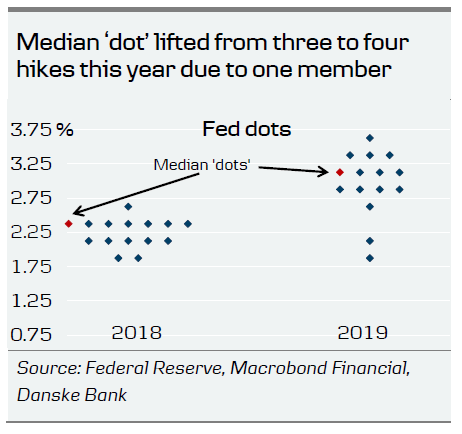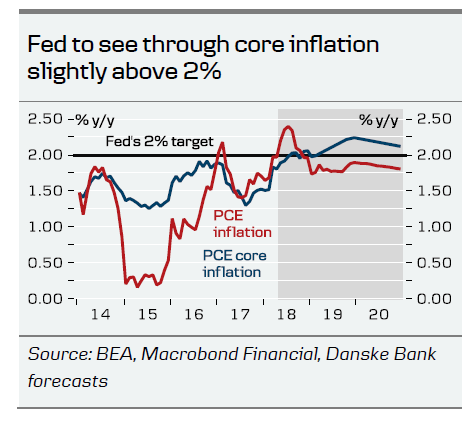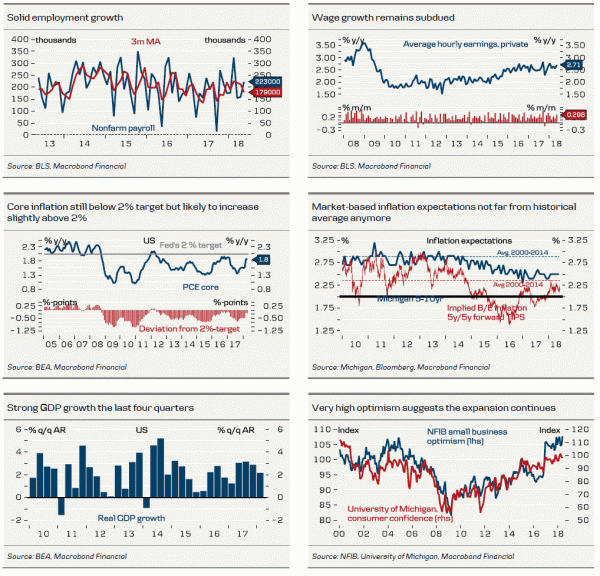The Fed raised the target range by 25bp to 1.75%-2.00% as expected (the interest rate on excess reserves was only lifted by 20bp to 1.95% in order to keep the effective Fed funds rate closer to the mid of the range) as the Fed is still bullish on the economy.
The median ‘dot’ for this year was lifted from signalling a total of three hikes to four hikes although only one member lifted his or her dot. The Fed has decided to remove many soft sentences making the statement shorter, as Powell wants more flexibility now the Fed funds rate is close to neutral. The FOMC no longer says that it is monitoring inflation ‘carefully’, that it expects ‘further gradual [rate] increases’ and perhaps most importantly that the Fed funds rate ‘is likely to remain, for some time, below levels that are expected to prevail in the longer-run’. Powell said during the press conference the latter was because the target range is now close to neutral (so basically in line with what we expected, although we thought the change would be made where the Fed states that ‘monetary policy is accommodative’). This is slightly more hawkish than we had expected and we now think it is more likely than not the Fed is going to hike both in September and December (previously only in December) although it is still a close call. The committee remains divided between three and four.
The Fed still signals three hikes in 2019. The longer-run dot was unchanged at 2.875%, so we are only four hikes away from neutral, where monetary policy is neither expansionary nor contractionary. The Fed still signals the target range is moving slightly above neutral over the next few years (so still says it is time to gently hit the brakes to avoid an overheating).
Powell said during the press conference that the Fed will not ‘overreact’ to PCE core inflation moving above 2% and that ‘it is too early to declare victory over inflation’. One could argue that the Fed has de facto shifted to some sort of partial price level targeting but Powell said that the formal discussions are ‘not in the calendar right now’.
Powell confirmed he will hold a press conference at every meeting starting from January (projections are still updated on a quarterly basis). This is positive, at it means we will get more information at the small meeting. Powell continues to be more explicit and direct than Yellen, which is positive, as it increases transparency.
EUR/USD fell on impact but partially erased the initial move as Powell stressed that an inflation overshoot will be allowed (USD negative) and as a WSJ story separately reported on the more concrete plans for US tariffs on Chinese goods. In any case, today’s confirmation that the Fed is on autopilot, underlines the ‘carry appeal’ of USD, which should ensure demand for the greenback for some time still. Next up is the ECB, and while it is a close call, we are looking for the ECB to refrain from putting an end date on QE and thus expect EUR/USD to drop on announcement and edge a bit higher on some nonetheless hawkish comments as Draghi starts speaking. Bottomline: Fed and ECB in combination halting the recent EUR/USD rebound and the cross should remain broadly within the 1.15-1.21 range on a 6M horizon














